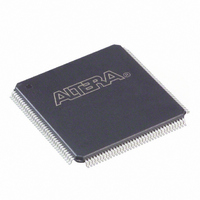EPM3256ATI144-10N Altera, EPM3256ATI144-10N Datasheet - Page 14

EPM3256ATI144-10N
Manufacturer Part Number
EPM3256ATI144-10N
Description
IC MAX 3000A CPLD 256 144-TQFP
Manufacturer
Altera
Series
MAX® 3000Ar
Datasheet
1.EPM3032ATC44-10N.pdf
(46 pages)
Specifications of EPM3256ATI144-10N
Programmable Type
In System Programmable
Delay Time Tpd(1) Max
10.0ns
Voltage Supply - Internal
3 V ~ 3.6 V
Number Of Logic Elements/blocks
16
Number Of Macrocells
256
Number Of Gates
5000
Number Of I /o
116
Operating Temperature
-40°C ~ 100°C
Mounting Type
Surface Mount
Package / Case
144-TQFP, 144-VQFP
Voltage
3.0 V ~ 3.6 V
Memory Type
EEPROM
Number Of Logic Elements/cells
16
Family Name
MAX 3000A
# Macrocells
256
Number Of Usable Gates
5000
Frequency (max)
125MHz
Propagation Delay Time
10ns
Number Of Logic Blocks/elements
16
# I/os (max)
116
Operating Supply Voltage (typ)
3.3V
In System Programmable
Yes
Operating Supply Voltage (min)
3V
Operating Supply Voltage (max)
3.6V
Operating Temp Range
-40C to 85C
Operating Temperature Classification
Industrial
Mounting
Surface Mount
Pin Count
144
Package Type
TQFP
Lead Free Status / RoHS Status
Lead free / RoHS Compliant
Features
-
Lead Free Status / Rohs Status
Compliant
Other names
544-1992
EPM3256ATI144-10N
EPM3256ATI144-10N
Available stocks
Company
Part Number
Manufacturer
Quantity
Price
Company:
Part Number:
EPM3256ATI144-10N
Manufacturer:
NICHICON
Quantity:
30 000
Company:
Part Number:
EPM3256ATI144-10N
Manufacturer:
ALTERA31
Quantity:
135
Part Number:
EPM3256ATI144-10N
Manufacturer:
ALTERA/阿尔特拉
Quantity:
20 000
MAX 3000A Programmable Logic Device Family Data Sheet
14
Programming Sequence
During in-system programming, instructions, addresses, and data are
shifted into the MAX 3000A device through the TDI input pin. Data is
shifted out through the TDO output pin and compared against the
expected data.
Programming a pattern into the device requires the following six ISP
stages. A stand-alone verification of a programmed pattern involves only
stages 1, 2, 5, and 6.
1.
2.
3.
4.
5.
6.
Programming Times
The time required to implement each of the six programming stages can
be broken into the following two elements:
■
■
Enter ISP. The enter ISP stage ensures that the I/O pins transition
smoothly from user mode to ISP mode. The enter ISP stage requires
1 ms.
Check ID. Before any program or verify process, the silicon ID is
checked. The time required to read this silicon ID is relatively small
compared to the overall programming time.
Bulk Erase. Erasing the device in-system involves shifting in the
instructions to erase the device and applying one erase pulse of
100 ms.
Program. Programming the device in-system involves shifting in the
address and data and then applying the programming pulse to
program the EEPROM cells. This process is repeated for each
EEPROM address.
Verify. Verifying an Altera device in-system involves shifting in
addresses, applying the read pulse to verify the EEPROM cells, and
shifting out the data for comparison. This process is repeated for
each EEPROM address.
Exit ISP. An exit ISP stage ensures that the I/O pins transition
smoothly from ISP mode to user mode. The exit ISP stage requires
1 ms.
A pulse time to erase, program, or read the EEPROM cells.
A shifting time based on the test clock (TCK) frequency and the
number of TCK cycles to shift instructions, address, and data into the
device.
Altera Corporation














